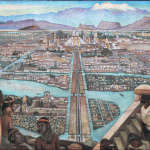
In both editions of my book Abraham Divided, I devoted several pages to words that the English language has borrowed from Arabic (and, if I recall correctly, to at least one word borrowed from Persian). For whatever reason, I find etymologies fascinating. And I can justify their inclusion in this book because I think they provide an interesting window into the richness and variety of Islamic civilization. In any case, I plan to add some additional etymological specimens — this time, not confining myself only to Arabic, since the new book itself will be covering the Islamic world beyond the Arabs — to what will be, in important ways, a new book rather than simply a third edition of the old one. Here are a few preliminary notes toward that end:
adobe — derives via Spanish (where it means “sun-dried brick”) from the Arabic term الطوبة al-tūba (or at-tūba, “the brick”), which may itself have been borrowed from Coptic. One of my favorite memories from the age of eleven or twelve is making frames with a friend, which we used to make adobe bricks and then, with them, to build a small adobe cabin or hut in his capacious back yard. I have no recollection of why we decided to do it, but I do remember very well the sense of accomplishment that we had.
cotton — comes quite straightforwardly from the Arabic قطن (qutn or qutun), which means . . . well, “cotton.”
The fabrics known as damask and muslin — take their names from the cities with which they were associated: Damascus (دمشق, dimashq), in Syria, and Mosul (الموصل, al-Mawṣil, or, in the Kurdish pronunciation Mûsil ,مووسڵ), which is located in Mesopotamia or, in today’s political terminology, in Iraq. Muslin, or موصلي (mūsilī), is a fine lightweight fabric that is usually made of cotton but is sometimes made from linen.
crimson — comes to us from قرمزي (qirmizī or qirmazī), which refers to the color of a class of crimson dye that was used in the medieval Islamic period for dyeing silk and wool. The insect from which the dye is made is called qirmiz. The word may ultimately come from a Sanskrit term, krmi-ja (“worm produced”)
check, checkmate, chess, exchequer, cheque, chequered, unchecked, checkout, checkbox, checkbook — Every one of the preceding words derives by one route or another from the Persian word شاه (shāh, “king”). Chess, a very old Persian war game, was introduced to medieval Europe through the Arabs. There is also a suggestion that the chess term checkmate comes from الشيخ مات, “The shaykh is dead,” but I think this unlikely. More plausible for many reasons, in my judgment, is the idea that it comes from the Arabo-Persian sentence شاه مات (shāh māt, “The king is dead”).
alcove — also came to English through Spanish, from القبّة (al-qubba, “vault,” “dome,” or “cupola”).
alfalfa — is a corruption of the Arabic word الفصفصة (al-fisfisa,” alfalfa”)
apricot — apparently comes originally from the classical Latin praecoqua, which literally means “precocious” and probably referred specifically to “precociously” ripening peaches (i.e. apricots). The Latin term came into early Byzantine Greek, and Arabic adopted it as البرقوق (al-barqūq, “apricot”). The Arabic word passed into late medieval Spanish albarcoque and Catalan albercoc, each of them also meaning “apricot.” The letter t that appears in today’s English apricot comes from the word’s passage through French.
artichoke — The English term comes to us from the Arabic words الخرشف (al-kharshuf) and الخرشوف (al-kharshūf), both of which mean mean “artichoke,” via a quite complex evolution that has also left its traces in French and Italian as well as in Spanish.
aubergine — Eggplant, as aubergine is also known, seems to be native to India and to have been wholly unknown to both the ancient Greeks and the Romans. It was introduced into the Mediterranean region by the Arabs as البادنجان (al-bādinjān), which comes from the Sanskrit plant name vatin-gana.
candy — The medieval Persian word gand (“cane sugar”) probably derived from Sanskrit. (Cane sugar was developed in ancient India.) It came to refer to a hard candy that was made by boiling cane sugar. From it derived the Arabic words قند (qand, “[cane] sugar”) and قندي (qandī, “sugared” or “sugary”).
jar (a container for food or for drink) — comes pretty clearly via Spanish from the Arabic جرّة (jarra), which denotes an earthenware jar, an upright container that has been made of pottery. The meaning has obviously shifted somewhat, as we typically have glass jars, and they are considerably smaller than the earthenware vessels bearing the name in Arabic.
julep (type of drink) — In Persian, gulab referred to “rose water.” The word was taken up by the Arabs, with the same meaning, as جلاب (julāb), and came to refer generally to a syrupy drink.
hashish — The Arabic word حشيش (hashīsh), can refer to grass, but it has specialized meanings of “dried herb” and “rough grass” as well as referring to hemp that is grown for textile fiber. Its use in Arabic as a nickname for cannabis or marijuana can evidently be traced to at least the twelfth or thirteenth century
assassin — comes from الحشيشية (al-hashīshīya) or, even more likely, from حشيشين (hashīshīn). Those terms were Arabic nicknames for the Nizari Ismaili sect of Shi‘i Islam, with which the Crusaders had become acquainted during their time in Syria and Palestine. The Nizaris carried out numerous assassinations not only against leaders of other religious sects and against rulers of the Crusader states but also against Muslim governors and princes who stood in their way. Supposedly, they got themselves nerved up for their homicides through the use of hashish. (Candidly, though, I find this quite implausible. They were extremely effective, and I find it hard to credit the suggestion that they carried out their legendarily deft assassinations while high in a haze of hash. I grew up in California in the 1960s, and I saw the drug’s effect on more than a few of my friends.). The generalization of the Nizari sect’s nickname into a reference to “assassins” more generally apparently occurred in Italian at the beginning of the fourteenth century.
average — The derivation of this English word from the Arabic عوار (ʿawār, “a defect,” “anything defective or damaged, including partially spoiled merchandise”) and عواري (ʿawārī [also عوارة ʿawāra], “of or relating to ʿawār, a state of partial damage”), connected with the verb عور (“to lose an eye”), is probably too complex to get into (and, frankly, requires a bit of faith), but seems to be, so far as I’m aware, largely unchallenged among etymologists.
carat (as a measure of gold purity) and carat (as a measure of mass) — comes directly from the Arabic قيراط (qīrāt), which refers to a small unit of weight that is defined as one twenty-fourth of the weight of the medieval Arabic gold coin called the dinar (from the Latin denarius) or, alternatively, as the weight of three barley seeds. The word was also used in medieval Arabic to refer to one twenty-fourth of the monetary value of a dinar.












